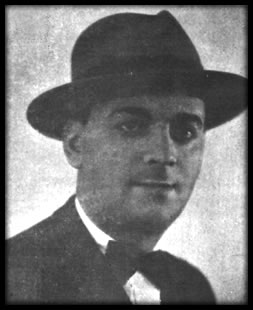By
Lopecito, a pioneer at spreading tango

horoughly porteño, this man was born in the neighborhood of San Telmo, on 525 Paseo Colón Avenue, his full name Juan Francisco López. At that place his father ran a grocery store with a typical drinkery which was frequented by payadores (itinerant singers), singers and musicians. Since his early years this environment connected him to all those genuinely popular manifestations of Buenos Aires. To that neighborhood, beloved and always remembered, Lopecito would sing years later:
¡San Telmo!
Pa’ cantarte, mi barrio,
me puse el pañuelo,
no puedo mentirte,
vos me conocés...
Y aunque va pa’ tiempo
que no me ves el pelo,
de nuevo he venido
pa’ verte otra vez.
 Perhaps he was not the first, but he is regarded as the pioneer of airing tango pieces through radio programs designed for that purpose. He was famous since 1937 with his program De Villoldo a Gardel broadcasted by Radio Argentina at noon. In it he reminisced the music and the men of early tango. Spiced with poems and commentaries of his own harvest, full of tasty Buenos Aires stuff. That program started with the Villoldo’s tango “El esquinazo” played by the Roberto Firpo quartet.
Perhaps he was not the first, but he is regarded as the pioneer of airing tango pieces through radio programs designed for that purpose. He was famous since 1937 with his program De Villoldo a Gardel broadcasted by Radio Argentina at noon. In it he reminisced the music and the men of early tango. Spiced with poems and commentaries of his own harvest, full of tasty Buenos Aires stuff. That program started with the Villoldo’s tango “El esquinazo” played by the Roberto Firpo quartet.
El tango:
nació en un patio porteño
a la luz de un farolito,
lo reclamó un organito
al encontrarlo sin dueño...
Cuando despertó del sueño
se enrolló en el carretel,
se fue hasta la torre Eiffel,
dejó el tabaco, el escabio
y se hizo rezo en los labios
del gran Carlitos Gardel.
He was a theater playwright, poem writer and improviser, actor and announcer of tango shows. He got in touch with theater when he was very young and appeared as actor in some plays.
José Barcia stated that 88 plays of the género chico criollo were written by him. The first one was Triunvirato está de fiesta, premiered by Olinda Bozán.
Because of his experience as actor and specially due to his natural skills he was able to convey to his voice the brave shades of the outskirts and, furthermore, to reflect the agressiveness that in many sectors the displacement of tango by foreign rhythms caused.
De Villoldo a Gardel was a title in which he molded his love towards tango. He as well conducted a program titled Esquinas Porteñas on La Voz del Aire radio station, Radio Del Pueblo and Radio El Mundo and he also published on papers his articles known as Acuarelas Porteñas.
He devised shows at theaters with tango material and his canyengue way of saying as an extension of his radio programs. He appeared in small venues in our capital and in numerous towns of the country. He was backed by an orchestra comprised of Nicolás Vaccaro (piano), Domingo Petillo (violin), Juan Bautista Guido and José María Bianchi (bandoneons). Esteban Rovatti and Vicente Sabio were as well its members.
Thereafter he appeared with the trio Los Muchachos de Antes, lined-up by Panchito Cao, Horacio Malvicino and Aldo Nicolini.
In 1942 he ventured into the movies. On December 18 La cabalgata del tango, a film written, commentated and directed by Lopecito himself, was premiered. It included the 10 short films featuring Carlos Gardel and Ignacio Corsini, Oscar Alonso, Alberto Margal, the Orquesta Típica Argentina —whose members were musicians that had recently split with Osvaldo Fresedo, as well as the vocalist Ricardo Ruiz— also appeared. Furthermore, there were a quartet of the Guardia Vieja (old style) and dancing partners.
With the passing of time tango was no longer the most important music in our city which was losing the physiognomy and the classic profile of the man of Buenos Aires. Lopecito was out of his environment and decided to look for a different one, but with similar features. He cast anchor facing the sea in the city of Mar del Plata. There he continued with what he liked, especially broadcasting tangos on the radio and nearly at age 90 his life ended.
From his oeuvre we can highlight his evocative stanzas to the Zorzal Criollo “A Carlitos Gardel”. This «acuarela porteña», as Héctor Lucci defined it, was recorded in 1934 and has two aspects to highlight. Firstly, it is an element more of the many ones that exist to demonstrate that Gardel's popularity was not built after his death. These verses were written before the fatal accident of Medellín.
Secondly, when these lines are read, although when read by anyone they can be inadvertently heard, they recover an uncommon life and grace when heard recited by the author. They are included, after a short previous chat, in the compact disc Siempre el tango en el disco, volumen 1.